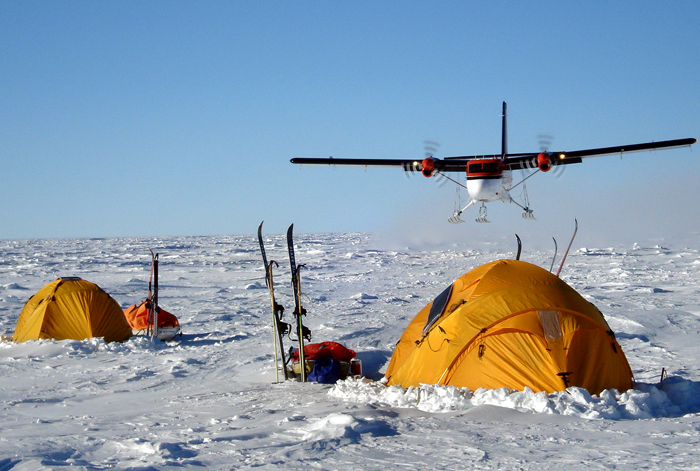|
Page 3/3 - Posted November 6, 2008
Safety concernsThe fly-in trips, by their nature, are structured and easy for the station to manage. On the other hand, expeditions can arrive any time of the day, though a company like ALE addresses these concerns by keeping in communication with the South Pole so that personnel know roughly when to expect an arrival. ALE thoroughly briefs all their expeditions, pilots, and guides on South Pole procedures and provides them with copies of the ASMA maps, according to Rootes. “The lack of advance knowledge of [some] expeditions arriving at South Pole is problematic in terms of station impact, and in some cases, could be a safety problem in terms of aircraft landings without sufficient knowledge in advance on our part,” explained Polly Penhale, environmental officer for the NSF’s Office of Polar Programs There are also other hazards, such as exposed fuel lines, and sensitive science areas that are off-limits because the experiments require clean air for atmospheric studies or quiet for seismic measurements. “I’ve noticed an increasing number of planned expeditions in the near future, with the anniversary of important milestones in the race to the Pole,” Penhale added. Grand adventuresRootes said that expeditions are indeed on the upswing. Most of the longer trips originate out of Hercules Inlet on the coast, taking about 50 days to complete a one-way ski trip to the Pole. (The current record is 40 days.) ALE then flies the expedition team out, though some opt to kite sail back in less than half the time. Some seek to claim the dwindling number of South Pole records or to recreate past feats of adventure. For example, descendants of Sir Ernest Shackleton’s team plan to retrace the footsteps of the Nimrod Expedition of 1909, when the original adventurers got within 97 miles of the Pole before turning back (see Matrix Shackleton Centenary Expedition Watson recalled a visit by an expedition of Indian Navy men. “They skied in a line. It was quite impressive to see them come in,” she said. But it seems the hardcore, professional adventurer is the exception rather than the rule these days. Rootes conceded that the overall experience of people participating in some of these guided adventures is falling. “There are few real expedition people out there,” he said, but added that the company extensively screens its clients beforehand. “We want expeditions to succeed in their goals and often advise them to gain more experience if we don’t think they have necessary skills,” he explained. “As a result, we turn away as many as we take down. It’s no point in us charging a fortune to take ill-prepared expeditions down there, if they’re going to peter out halfway through and we have to rescue them. It just causes grief all round.” Zero impactThe companies are expected to handle all their own logistics, including any search and rescue missions. Rootes said the ideal is to have zero impact on the USAP or any other nation. The company has its own medical personnel and keeps a cache of supplies and fuel at the South Pole should any tourists get stuck due to weather or other problems. “We try to be as self-contained as possible,” he said. “If anybody has to [use] any services at the Pole, then we haven’t achieved what we feel like we want to achieve, which is to minimize our impact on the Pole in terms of what they’re doing.” Government workALE is not only in the tourism business. It increasingly plays a part in providing logistic support for national science programs on the continent, its Patriot Hills camp ideally suited to support work in West Antarctica. For instance, scientists with the NSF-funded project POLENET The company has also worked with the British Antarctic Survey “The service varies from program to program,” Rootes said. “For example, for the Koreans, we provided a complete field support package including flights, snowmobiles, guides, etc. For NSF, we prepared a Herc skiway, provided accommodation, food and fuel, and they did the rest.” The futureWhat effect the current worldwide economic downturn might have on the future of Antarctic tourism is uncertain at this time, though Rootes expects another busy season this year, with the company flying three Twin Otters this year rather than just two. Marty, NSF’s South Pole representative, said the station will continue to evolve to manage the burgeoning tourist industry without neglecting its primary mission of science support and discovery. “We’re learning from the experiences,” Marty said. Back 1 2 3 |



For USAP Participants |
For The Public |
For Researchers and EducatorsContact UsU.S. National Science FoundationOffice of Polar Programs Geosciences Directorate 2415 Eisenhower Avenue, Suite W7100 Alexandria, VA 22314 Sign up for the NSF Office of Polar Programs newsletter and events. Feedback Form |


